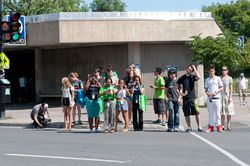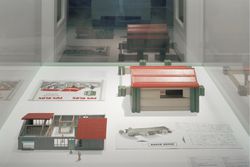Seeing, perceiving, viewing, envisioning: each is a form of framing that mediates between inside and outside, public and private, what’s evident and what’s hidden. Georges Teyssot, Professor at Université Laval’s School of Architecture in Quebec City and author of A Topology of Everyday Constellations (The MIT Press, 2013), analyzes how the notions of window, door, frame,(...)
Shaughnessy House
19 February 2015 , 6pm
Windows and Screens: Georges Teyssot
Actions:
Description:
Seeing, perceiving, viewing, envisioning: each is a form of framing that mediates between inside and outside, public and private, what’s evident and what’s hidden. Georges Teyssot, Professor at Université Laval’s School of Architecture in Quebec City and author of A Topology of Everyday Constellations (The MIT Press, 2013), analyzes how the notions of window, door, frame,(...)
Shaughnessy House
The Unschool
What could a school be? For a week over summer 2012, students of The Unschool explored the spaces in and around schools and pushed the limits of the camera as a social instrument with guest curator Monica Nouwens. Participants compared how people live in schools and cities, and how design can encourage and limit behaviours, relationships, and activities. “Could(...)
30 July 2012 to 3 August 2012
The Unschool
Actions:
Description:
What could a school be? For a week over summer 2012, students of The Unschool explored the spaces in and around schools and pushed the limits of the camera as a social instrument with guest curator Monica Nouwens. Participants compared how people live in schools and cities, and how design can encourage and limit behaviours, relationships, and activities. “Could(...)
Liquidated Architecture
American urban planner and designer Damon Rich examines the links among politics, architecture, and history. His research analyses the evolution of the real estate market – foreclosures, mortgages, construction and zoning. He is also a collaborator of the Center for Urban Pedagogy (CUP), an organization based in Brooklyn that studies movements within cities and their(...)
Paul Desmarais Theatre
26 February 2009
Liquidated Architecture
Actions:
Description:
American urban planner and designer Damon Rich examines the links among politics, architecture, and history. His research analyses the evolution of the real estate market – foreclosures, mortgages, construction and zoning. He is also a collaborator of the Center for Urban Pedagogy (CUP), an organization based in Brooklyn that studies movements within cities and their(...)
Paul Desmarais Theatre
Dream Houses, Toy Homes
Through selections from the CCA’s collection of architectural toys and games, including 33 European and North American architectural toys dating from the early nineteenth century to 1995, Dream Houses, Toy Homes examines the notions of home, childhood, play, gender, and learning. The exhibition uncovers the potential of toys to embody images and ideas of domestic(...)
Dream Houses, Toy Homes
Actions:
Description:
Through selections from the CCA’s collection of architectural toys and games, including 33 European and North American architectural toys dating from the early nineteenth century to 1995, Dream Houses, Toy Homes examines the notions of home, childhood, play, gender, and learning. The exhibition uncovers the potential of toys to embody images and ideas of domestic(...)
textual records
AP140.S2.SS4.D1.P4
Description:
mostly sketches for book layout and some correspondence from publisher Gerd Hatje, dated between 1972 and 1974, including: folder 1 - letter from Gerd Hatje to James Stilring, dated 18 February 1972, passing on reader's comments ("I have the feeling these comments are made by Robert (sic) Middleton, but I'm not sure."), annotated in red ink by James Stirling with preliminary responses - letter from James Stirling to gerd Hatje, dated 29 Feb 1972, responding to comments - mock-up of cover and inside page, "Presentation by Leon Krier," "Buildings & Projects / 1950 - 1973" - photocopy of illustrations and labels to accompany John Jacobus introduction - stapled and bound set of photocopies of Leon krier drawings for Derby - alternate versions for cover of book, photocopies, some annotated in green ink, inscribed: "Presentation by Leon Krier" and then annotated "layout by Leon Krier or design by Leon Krier" folder 2 - page layouts, mostly photocopies with at least one original layout (black ink), some pages annotated or check-marked in red marker - page layouts for book, chronology of projects, captions, numbers of words for each project, mostly photocopy, some ink, some annotated folder 3 (labelled "Book Preparation" - three alternate designs for cover, originals, black and red ink on tracing paper - complete original book layout, mostly black ink, some red ink and brown marker on tracing paper folder 4 - "Chronological List of Works by James Stirling 1950 - 1972," photocopy from A+U Feb 1975, annotated - book layout, annotated with letters keyed to captions in red marker, annotated in red ink throughout - letter from James Stirling to gerd Hatje, 24 Jan 1975, doesn't like typeface chosen by Gerd Hatje ("returned marked 'nein'"), notes other specific preferences regarding dust jacket (Bembo 270 typeface, red "JS" as previously decided, axonometric will be half-size, cover should be glossy black) - letter from Ruth Wurster (Verlag Gerd Hatje) to James Stirling, 4 Feb 1975, enclosing proofs of title pages - letter from James Stirling to Gerd Hatje, responding to letter from Ruth Wurster folder 5 - book layout, photocopy, a few corrections in red marker
1972 -1974
Mostly sketches for book layout and some correspondence
Actions:
AP140.S2.SS4.D1.P4
Description:
mostly sketches for book layout and some correspondence from publisher Gerd Hatje, dated between 1972 and 1974, including: folder 1 - letter from Gerd Hatje to James Stilring, dated 18 February 1972, passing on reader's comments ("I have the feeling these comments are made by Robert (sic) Middleton, but I'm not sure."), annotated in red ink by James Stirling with preliminary responses - letter from James Stirling to gerd Hatje, dated 29 Feb 1972, responding to comments - mock-up of cover and inside page, "Presentation by Leon Krier," "Buildings & Projects / 1950 - 1973" - photocopy of illustrations and labels to accompany John Jacobus introduction - stapled and bound set of photocopies of Leon krier drawings for Derby - alternate versions for cover of book, photocopies, some annotated in green ink, inscribed: "Presentation by Leon Krier" and then annotated "layout by Leon Krier or design by Leon Krier" folder 2 - page layouts, mostly photocopies with at least one original layout (black ink), some pages annotated or check-marked in red marker - page layouts for book, chronology of projects, captions, numbers of words for each project, mostly photocopy, some ink, some annotated folder 3 (labelled "Book Preparation" - three alternate designs for cover, originals, black and red ink on tracing paper - complete original book layout, mostly black ink, some red ink and brown marker on tracing paper folder 4 - "Chronological List of Works by James Stirling 1950 - 1972," photocopy from A+U Feb 1975, annotated - book layout, annotated with letters keyed to captions in red marker, annotated in red ink throughout - letter from James Stirling to gerd Hatje, 24 Jan 1975, doesn't like typeface chosen by Gerd Hatje ("returned marked 'nein'"), notes other specific preferences regarding dust jacket (Bembo 270 typeface, red "JS" as previously decided, axonometric will be half-size, cover should be glossy black) - letter from Ruth Wurster (Verlag Gerd Hatje) to James Stirling, 4 Feb 1975, enclosing proofs of title pages - letter from James Stirling to Gerd Hatje, responding to letter from Ruth Wurster folder 5 - book layout, photocopy, a few corrections in red marker
textual records
1972 -1974
Learning from... Nairobi
Italian documentary and architecture photographer Filippo Romano presents his ongoing study of Nairobi’s exploding slums. The city is represented through the many portraits of residents, workers and communities he captured, giving evidence of the built environment that shapes local urban cultures. The Learning From… series takes its title from Learning From Las Vegas(...)
Paul-Desmarais Theatre
9 October 2014 , 6pm
Learning from... Nairobi
Actions:
Description:
Italian documentary and architecture photographer Filippo Romano presents his ongoing study of Nairobi’s exploding slums. The city is represented through the many portraits of residents, workers and communities he captured, giving evidence of the built environment that shapes local urban cultures. The Learning From… series takes its title from Learning From Las Vegas(...)
Paul-Desmarais Theatre
Meat and dairy products are ubiquitous ingredients in the globe’s diet. However, the buildings that transform living beings into commodities are usually hidden from the public eye. The architecture of factory farming may seem anonymous and banal, and yet it is made possible by sophisticated technologies and practices of biosecurity. How was the design of intensive animal(...)
20 July 2023, 6pm to 7:30pm
Cages for non-humans: An architectural history of animal farming
Actions:
Description:
Meat and dairy products are ubiquitous ingredients in the globe’s diet. However, the buildings that transform living beings into commodities are usually hidden from the public eye. The architecture of factory farming may seem anonymous and banal, and yet it is made possible by sophisticated technologies and practices of biosecurity. How was the design of intensive animal(...)
Learning from... Athens
Konstantinos Pantazis, co-founder of Point Supreme, discusses the work of the Athens-based practice. The talk focuses on ways to challenge the current crisis condition, proactive proposals for improving the city, addressing the collective unconscious, and building without money. It presents the processes behind examples from the two opposite ends of Point Supreme’s(...)
Paul-Desmarais Theatre
7 April 2016, 6pm
Learning from... Athens
Actions:
Description:
Konstantinos Pantazis, co-founder of Point Supreme, discusses the work of the Athens-based practice. The talk focuses on ways to challenge the current crisis condition, proactive proposals for improving the city, addressing the collective unconscious, and building without money. It presents the processes behind examples from the two opposite ends of Point Supreme’s(...)
Paul-Desmarais Theatre
Members of the Montréal collective SYN-atelier d’exploration urbaine present a workshop investigating urban microclimates in downtown Montréal. Caused by particular conditions in urban construction, microclimates are environments that have surprising temperature variations — a building courtyard that is several degrees warmer than the street or a windy alley many degrees(...)
7 March 2009
Exploring Urban Microclimates
Actions:
Description:
Members of the Montréal collective SYN-atelier d’exploration urbaine present a workshop investigating urban microclimates in downtown Montréal. Caused by particular conditions in urban construction, microclimates are environments that have surprising temperature variations — a building courtyard that is several degrees warmer than the street or a windy alley many degrees(...)
Freegans
Hong Kong journalist Emily Rauhala speaks about the anticonsumerist philosophy of the “freegans” or “dumpster divers.” These individuals collect the tremendous quantities of still usable food and other goods that can be found in the trash containers of our cities, either to distribute to the needy or for their own personal use. Rauhala worked with Lorenzo Morales, a(...)
Paul Desmarais Theatre
8 January 2009
Freegans
Actions:
Description:
Hong Kong journalist Emily Rauhala speaks about the anticonsumerist philosophy of the “freegans” or “dumpster divers.” These individuals collect the tremendous quantities of still usable food and other goods that can be found in the trash containers of our cities, either to distribute to the needy or for their own personal use. Rauhala worked with Lorenzo Morales, a(...)
Paul Desmarais Theatre








